 |
JAVA: Servlets Lifecycle |
| << JAVA: Creating a Simple Web Application in Tomcat |
| JAVA: More on Servlets >> |
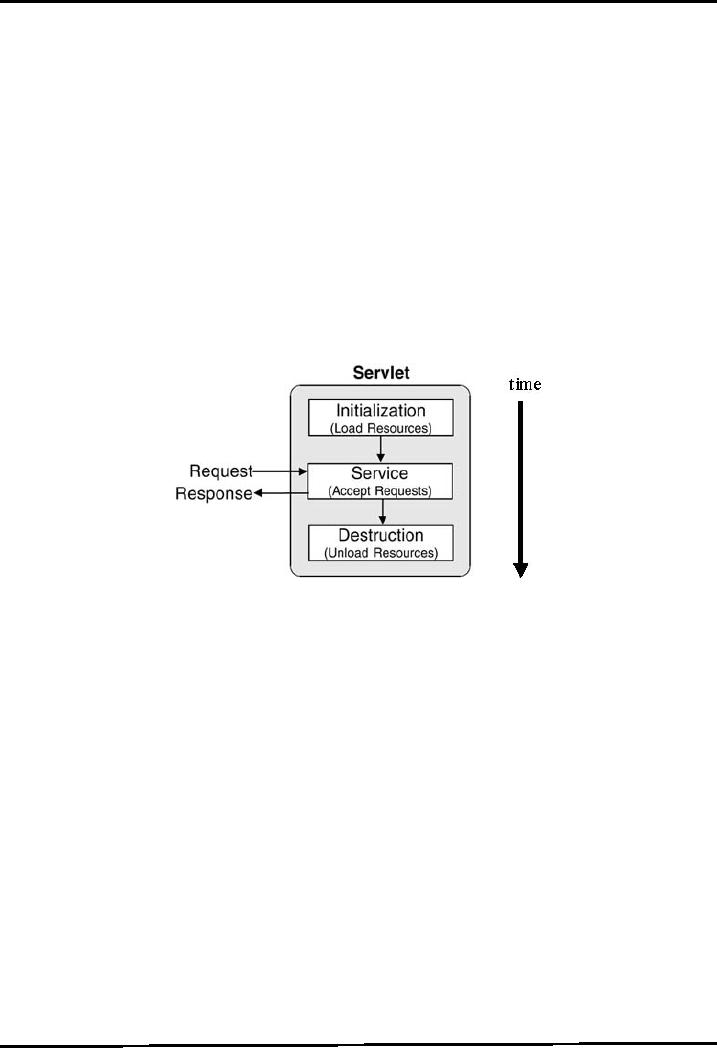
Web
Design & Development CS506
VU
Lesson
28
Servlets
Lifecycle
In the last
handout, we have seen how to
write a simple servlet. In
this handout we will look
more
specifically
on how servlets get created and destroyed.
What different set of method
are invoked during
the
lifecycle
of a typical servlet.
The
second part consists on
reading HTML form data
through servlet technology.
This will be explored
in
detail
using code example
Stages
of Servlet Lifecycle
A
servlet passes through the
following stages in its
life.
1
Initialize
2
Service
3
Destroy
As
you can conclude from the
diagram below, that with the
passage of time a servlet
passes through these
stages
one after another.
1.
Initialize
When
the servlet is first created, it is in
the initialization stage. The webserver
invokes he init() method of
the
servlet in this stage. It
should be noted here that
init() is only called once
and is not called for
each
request.
Since there is no constructor available in Servlet so
this urges its use
for one time
initialization
(loading
of resources, setting of parameters etc)
just as the init() method of
applet.
Initialize
stage has the following
characteristics and
usage
Executed
once, when the servlet gets
loaded for the first
time
Not
called for each client
request
The
above two points make it an
ideal place to perform the startup tasks
which are done in
constructor in a
normal class.
2.
Service
The
service() method is the engine of the servlet,
which actually processes the
client's request. On
every
request
from the client, the server
spawns a new thread and calls the service()
method as shown in the
figure
below. This makes it more
efficient as compared to the technologies
that use single thread to
respond
to
requests.
204
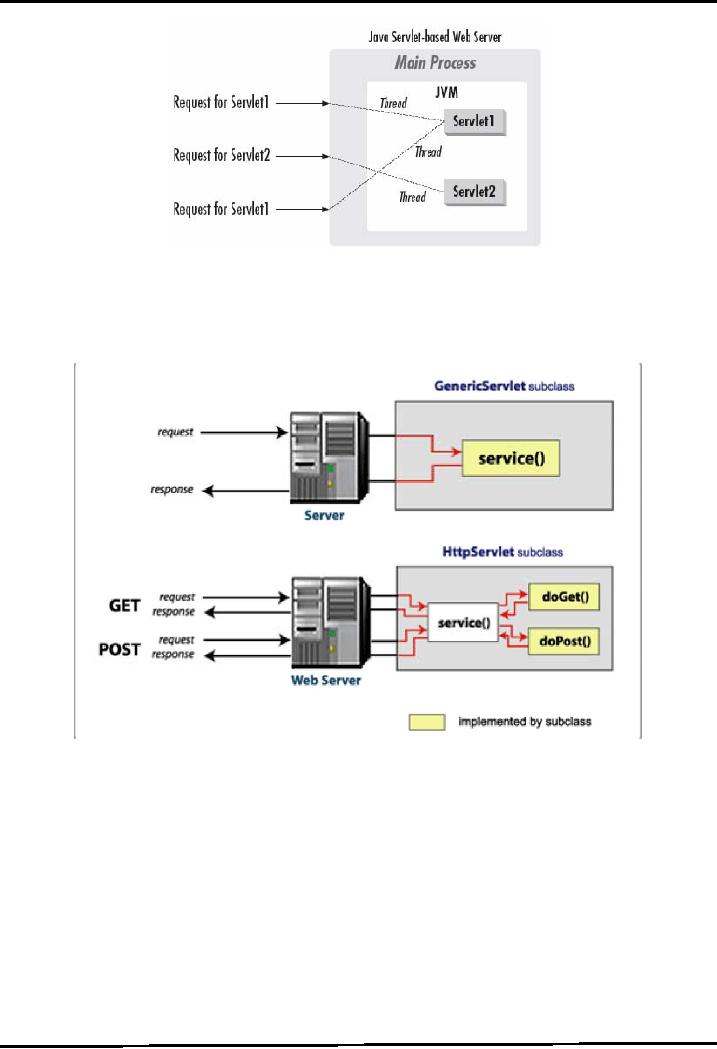
Web
Design & Development CS506
VU
The
figure below show both versions of the
implementation of service cycle. In the
upper part of
diagram,
we
assume that servlet is made
by sub-classing from GenericServlet.
(Remember, GenericServlet is
used
for
constructing protocol independent
servlets.). To provide the desired functionality,
service() method is
overridden.
The client sends a request
to the web server; a new thread is
created to serve this
request
followed
by calling the service() method. Finally a
response is prepared and sent back to the
user according
to the
request.
The
second part of the figure
illustrates a situation in which
servlet is made using
HttpServlet class.
Now,
this
servlet can only serves the
HTTP type requests.
205
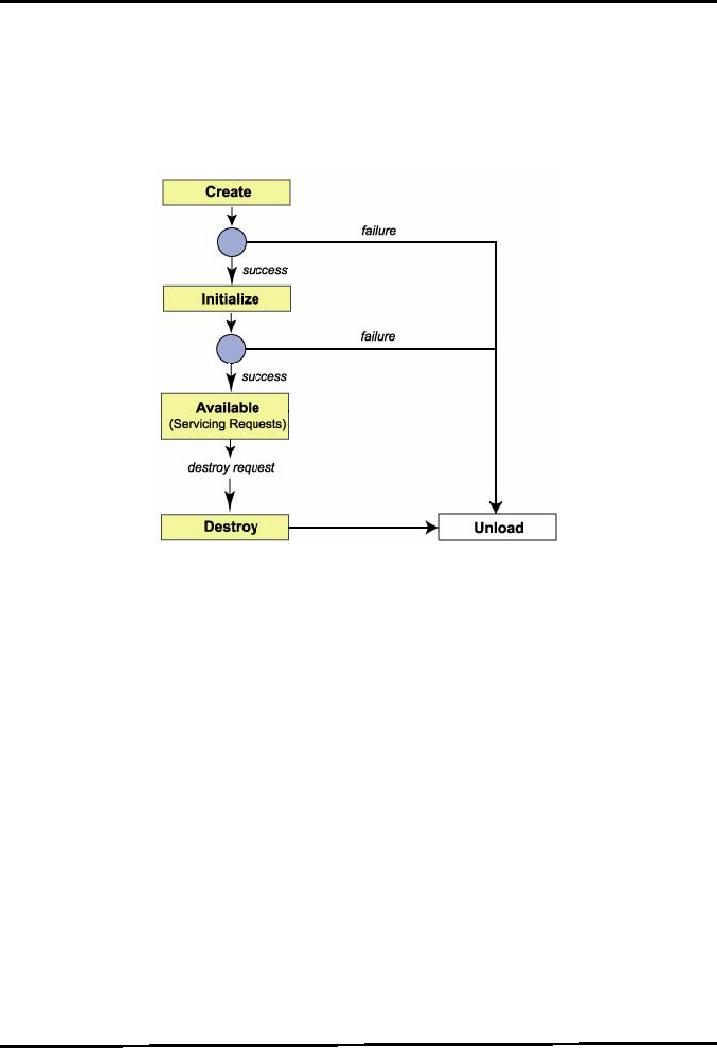
Web
Design & Development CS506
VU
Summary
A
Servlet is constructed and initialized.
The initialization can be
performed inside of init()
method.
Servlet
services zero or more requests by
calling service() method that may decide
to call further
methods
depending upon the Servlet
type (Generic or HTTP
specific)
Server
shuts down, Servlet is destroyed
and garbage is
collected
The
following figure can help to
summarize the life cycle of the
Servlet
The
web sever creates a servlet
instance. After successful creation, the
servlet enters into
initialization
phase.
Here, init() method is invoked
for once. In case web
server fails in previous two
stages, the servlet
instance
is unloaded from the
server.
After
initialization stage, the Servlet
becomes available to serve the
clients requests and to
generate
response
accordingly. Finally, the servlet is
destroyed and unloaded from web
server.
Reading HTML
Form Data Using
Servlets
In the
second part, the required
concepts and servlet technology is
explored in order to read HTML
form
data. To
begin with, let's first
identify in how many ways a
client can send
data
HTML &
Servlets
Generally
HTML is used as a Graphics User Interface
for a Servlet. In the figure
below, HTML form is
being
used as a GUI interface for
MyServlet. The data entered by the
user in HTML form is transmitted
to
the
MyServlet that can process
this data once it read
out. Response may be
generated to fulfil the
application
requirements.
206
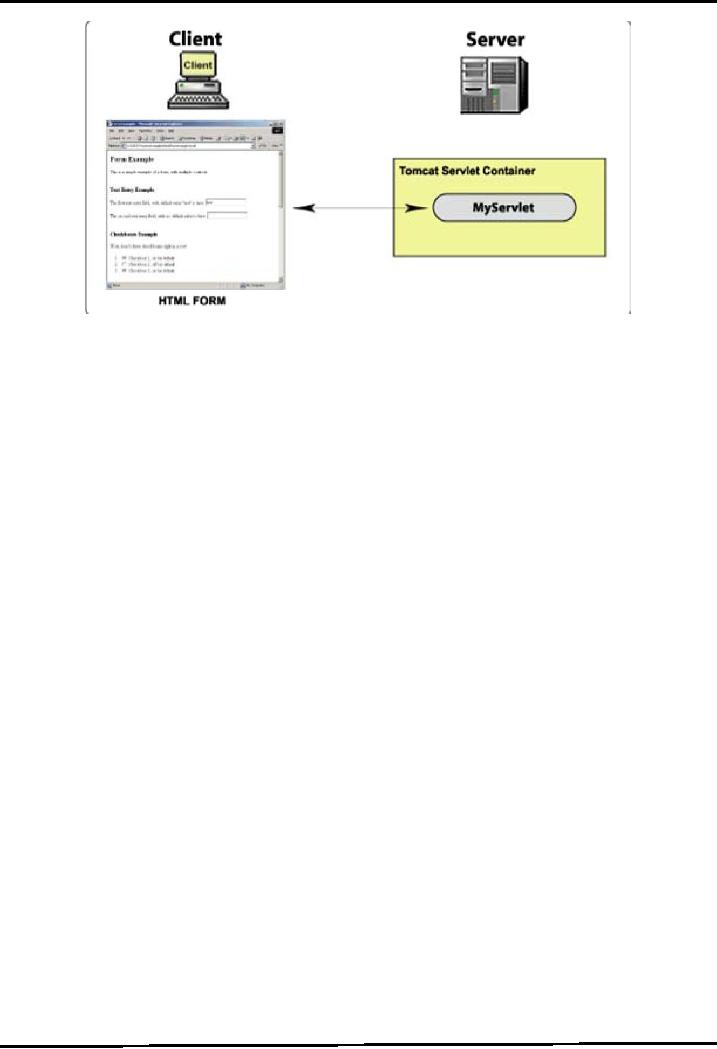
Web
Design & Development CS506
VU
207
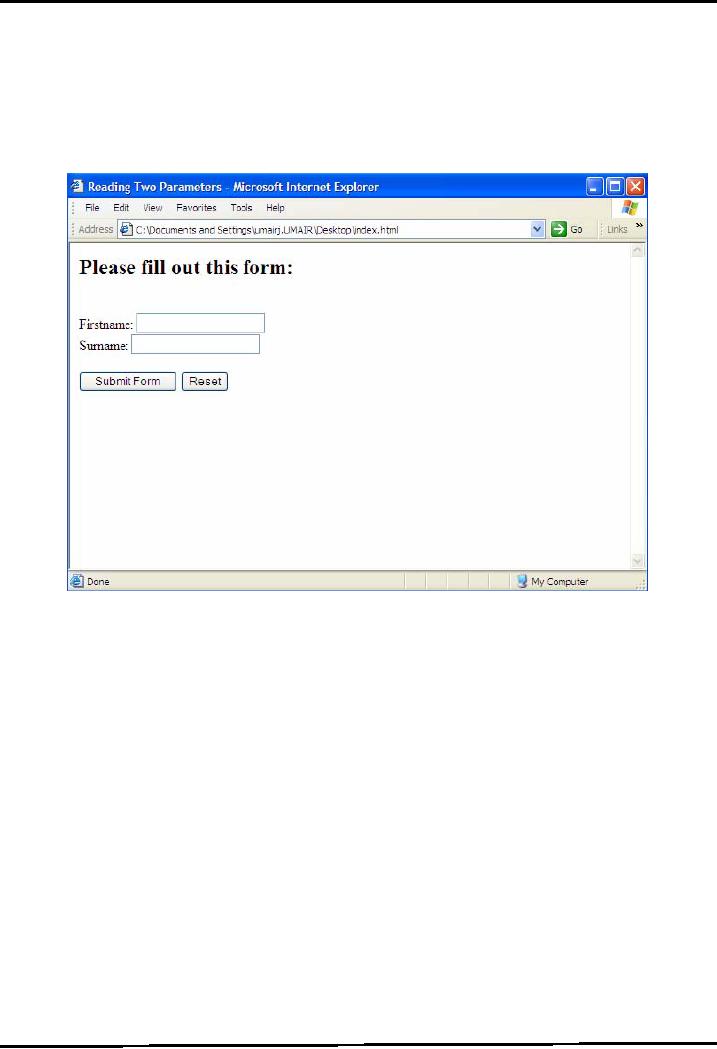
Web
Design & Development CS506
VU
Example
Code: Reading Form Data using
Servlet
This
example consists of one HTML page
(index.html), one
servlet (MyServlet.java) and one
xml file
(web.xml)
file.
The HTML page contains two
form parameters: firstName
and surName. The
Servlet
extracts
these specific parameters
and echoes them back to the browser after
appending "Hello".
Note:
The
example given below and
examples later in coming handouts
are built using netBeans®4.1.
It's
important
to note that tomcat server
bundled with netBeans® runs on
8084 port by default.
index.html
Let's
have a look on the HTML code used to
construct the above page.
<html>
<head>
<title>
Reading Two Parameters
</title>
</head>
<body>
<H2>
Please fill out this
form: </H2>
<FORM
METHOD="GET"
ACTION="http://localhost:8084/paramapp/formservlet"NAME="myform"
>
<BR>
Firstname:
<INPUT
TYPE = "text"
NAME="firstName">
<BR>
Surname:
<INPUT
TYPE = "text"
NAME="surName">
<BR>
<INPUT TYPE="submit" value="Submit
Form"> <INPUT
TYPE="reset"
value="Reset">
</FORM>
</body>
</html>
Let's
discuss the code of above HTML form. As
you can see in the
<FORM> tag, the attribute
METHODis
set
to "GET". The
possible values for this attribute
can be GET and POST. Now
what do these values
208

Web
Design & Development CS506
VU
mean?
Setting
the method attribite to "GET" means
that we want to send the
HTTP request using the
GET
method
which will evantually
activate the doGet() method of the
servlet. In the GET method the
information
in the input fields entered by the user,
merges with the URL as the
query string and
are
visible
to the user.
Setting
METHOD value to "POST" hides the entered
information from the user as
this information
becomes
the part of request body and activates
doPost() method of the servlet.
Attribute
ACTION of <FROM> tag is set to
http://localhost:8084/paramapp/formservlet. The
form data
will
be transmitted to this URL.
paramapp is the name of web
application created using
netBeans.
formservlet
is the value of <url-pattern>
defined in the web.xml. The
code of web.xml is given at the
end.
The
NAME attribute is set to "myform"
that helps when the same
page has more than one
forms.
However,
here it is used only for
demonstration purpose.
To
create the text fields where
user can enter data, following
lines of code come into
play
<INPUT
TYPE = "text" NAME="firstName">
<INPUT
TYPE = "text" NAME="surName">
Each
text field is distinguished on the
basis of name assigned to them.
Later these names also
help in
extracting
the values entered into these text
fields.
MyServlet.java
Now
lets take a look at the servlet
code to which HTML form data
is submitted.
import
java.io.*;import
javax.servlet.*;import
javax.servlet.http.*;
public
class MyServlet extends
HttpServlet{
public
void doGet(HttpServletRequest req,
HttpServletResponse
res)throws ServletException,
IOException{
//
reading first name
parameter/textfield
String
fName =
req.getParameter("firstName");
//
reading surname
parameter/textfield
String
sName =
req.getParameter("surName");
//
gettting stream from HttpServletResponse
objectPrintWriter out =
res.getWriter();
out.println("Hello:
" + fName + " " +sName ");
out.close();
}
}//
end FormServlet
We
started the code with
importing three packages.
import
java.io.*,
import
javax.servlet.*;
import
javax.servlet.http.*;
These
packages are imported to have the
access on PrintWriter, HttpServlet,
HttpServletRequest,
HttpServletResponse,
ServletException and IOException
classes.
The
class MySevlet extends from
HttpServlet to inherit the HTTP
specific functionality. If you
recall
HTML
code (index.html) discussed
above, the value of mehtod attribute
was set to "GET". So in this
case,
we
only need to override
doGet()Method.
Entering
inside doGet() method brings the
crux of the code. These
are:
String
fName = req.getParameter("firstName");
209

Web
Design & Development CS506
VU
String
sName = req.getParameter("surName");
Two
String variables fName and
sName are declared that receive
String values returned by
getParameter()
method. As
discussed earlier, this method returns
Stringcorresponds to the form parameter. Note
that the
values of
name attributes of input
tags used in index.html have
same case with the ones
passed to
getParameter()
methods as parameters. The
part of HTML code is reproduced over
here again:
<INPUT
TYPE = "text"
NAME="firstName">
<INPUT
TYPE = "text"
NAME="surName">
In the last
part of the code, we get the object of
PrintWriter stream from the
object of
HttpServletResponse.
This object will be used to
send data back the response.
Using PrintWriter
object
(out),
the names are printed with
appended "Hello" that
becomes visible in the browser.
web.xml
<?xml
version="1.0"
encoding="ISO-8859-1"?>
<web-app>
<servlet>
<servlet-name>
FormServlet
</servlet-name>
<servlet-class>
MyServlet
</servlet-class>
</servlet>
<servlet-mapping>
<servlet-name>
FormServlet
</servlet-name>
<url-pattern>
/formservlet
</url-pattern>
</servlet-mapping>
</web-app>
The
<servlet-mapping> tag contains two
tags <servlet-name> and <urlpatteren>
containing name and
pattern
of the URL respectively. Recall the
value of action attribute of the
<form> element in the HTML
page.
You can see it is exactly
the same as mentioned in <url-pattern>
tag.
http://localhost:8084/paramapp/formservlet
References:
JAVA a
Lab Course by Umair
Javed
Java
API documentation
Core Servlets
and JSP by Marty
Hall
210
Table of Contents:
- JAVA FEATURES
- Java Virtual Machine & Runtime Environment
- Learning Basics of JAVA
- JAVA: Object Oriented Programming
- JAVA: Inheritance
- JAVA: Collections
- JAVA: Intro to Exceptions
- JAVA: Streams
- JAVA: Modification of Address Book Code
- JAVA: Graphical User Interfaces
- JAVA: Event Handling
- JAVA: More Examples of Handling Events
- JAVA: Problem in Last Code Example
- Java Database Connectivity
- JAVA: More on JDBC
- JAVA: Result Set
- JAVA: Meta Data
- Java Graphics
- JAVA: How to Animate
- JAVA Applets
- JAVA: Socket Programming
- JAVA: Serialization
- JAVA: Multithreading 1
- JAVA: Multithreading 2
- JAVA Web Application Development
- Java Servlets
- JAVA: Creating a Simple Web Application in Tomcat
- JAVA: Servlets Lifecycle
- JAVA: More on Servlets
- JAVA: Dispatching Requests
- JAVA: Session Tracking 1
- JAVA: Session Tracking 2
- JAVA: AddressBook Case Study Using Sevlets
- Java Server Pages 1
- JavaServer Pages 2
- Java Server Pages 3
- JAVA: JSP Action Elements and Scope
- JAVA: JSP Custom Tags
- JAVA: MVC + Case Study
- JAVA: MVC Model 2 Architecture
- JAVA: Layers and Tiers
- JAVA: Expression Language
- JAVA: JavaServer Pages Standard Tag Library (JSTL)
- JAVA: Client Side Validation & JavaServer Faces (JSF)
- JAVA: JavaServer Faces